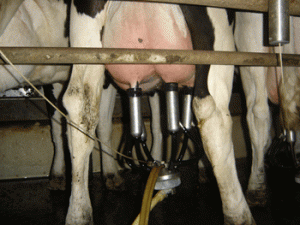The Minnesota DHIA Herd Summary report has three important tables to check to monitor the somatic cell count (SCC) status of the dairy herd. The Current SCC Evaluation table shows the number of cows and percent infected by lactation number and by linear score within each lactation. The Changes in SCC Status table shows the fresh vs. last dry off and current vs. last test percentages for cures, chronics, negatives, and new infections. The third table is the Yearly SCC Summary, showing the percent infected by days in milk and by lactation number.
When analyzing these tables in herds with mastitis problems, two questions especially come to my mind: why are the first lactation heifers infected; and, why are so many infected within less than 30 days in milk? For example, the DHI report may show 35 to 45% of first calf heifers infected within 30 days in milk or perhaps 30 to 40% complete their first lactation infected, some reaching linear scores of 6 or 7, indicating they are shedding high numbers of somatic cells.

Although it would be great if all first lactation heifers entered the milking string infection free, it cannot be assumed that this will ever be the case. Heifers can become susceptible to mastitis pathogens as soon as they begin to produce mammary secretions, as early as 6 to 8 months of age. Intra-mammary infections at any time thereafter can persist throughout pregnancy and into lactation.
What are some reasonable SCC goals to aim at with first lactation heifers?
- Uninfected heifers should have a SCC of less than 75,000 per ml by one week after calving.
- The number of clinical mastitis flare-ups in fresh heifers within the first two weeks of lactation should be less than 10% per year.
Sources of mastitis infection – Although it is not known for sure how heifers contract mastitis, sources may include:
- Bacteria that are on udder skin and have the opportunity to enter the teat orifice.
- Bacteria harbored in the oral cavities of calves, which suckle other calves.
- Bacteria present in the heifers’ environment, such as those found in soil, manure, and bedding material. Dirty hind feet and legs can also contaminate teat ends when heifers are lying down.
- Mastitis-causing bacteria on biting flies can be spread among heifers when flies congregate on teat ends. Research has shown that heifers in herds with fly control programs have lower prevalence of mastitis than in herds without fly control.
Solutions – University of Minnesota Diagnostic Lab culture records indicate that most of the mastitis in Minnesota dairies is coming from environmental pathogens. So in most cases, it comes down to hygiene and finding ways to reduce the number of mastitis-causing bacteria at the teat end, even for first lactation heifers. Here are some solution ideas:
- S.E. Nickerson, based on research at University of Georgia, (source: National Mastitis Council) suggests examining heifers for signs of mastitis either at the time of A.I. or pregnancy check when they are being handled anyway. Exam the developing udders, mammary fluid, and teat skin to help identify swollen quarters, abnormal secretions, and presence of teat scabs. These quarters are most likely to be infected and should be treated.
- Know the ‘bug’ you are dealing with so you can zero in on the problem. Collect and then culture aseptic milk samples from heifers that are fresh more than 7 days and have clinical mastitis or high SCC to determine the bacteria source. Examples: If it’s a contagious pathogen like Staph. aureus or Strep. ag., check milking practices, milking equipment, or post-dipping coverage. Also check for teat injuries or fly bites. When environmental Streps or coliforms are found, look at the bedding and housing areas, especially those for close-up animals, and check freestall or calving area cleanliness as well as effectiveness of milking practices in getting teat surfaces clean.
- Avoid wet, bacteria-laden areas for resting areas, whether indoors or outdoors. Heifers should calve in clean, sanitized, dry maternity pens, separated from other animals.
- Hutches and pens for calves and heifers should be well-bedded, clean, dry, and comfortable. Lots and pastures should be managed to prevent muddy areas where heifers would lie down.
- Remove any calf from a group that sucks on other calves or house calves in individual pens or hutches to prevent this.
- Dry treat heifers before calving.
First lactation heifers represent the future milking herd. Find out what is causing mastitis infections to show up within days of freshening. Then develop an action plan to reduce the level of SCC in future first lactation heifers. Lower SCCs in first lactation heifers could be a partial answer to a lower SCC for the whole herd.
